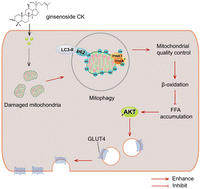Ginsenoside CK improves skeletal muscle insulin resistance by activating DRP1/PINK1-mediated mitophagy†
Abstract
Skeletal muscle insulin resistance is the main cause of type 2 diabetes, and mitochondria play a key role. Ginsenoside CK is the main active compound of ginseng with a variety of therapeutic effects, but few studies have reported on its mechanism towards skeletal muscle insulin resistance. Here, we found that CK significantly increased skeletal muscle insulin sensitivity, thereby alleviating hyperglycemia and insulin resistance. Furthermore, the effects of CK on skeletal muscle were associated with an improved mitochondrial fusion/fission dynamics balance and fatty acid oxidation. In fatty acid (FA)-induced C2C12 cells, CK promoted the translocation of GLUT4 to the cell membrane to improve glucose uptake and glycogen synthesis and also enhanced the mitochondrial quality. CK ameliorated the damaged mitochondrial membrane potential (ΔΨm), which was based on mitophagy activation. After the knockdown of mitophagy-related receptors, we found that DRP1/PINK1 was the key pathway of CK-induced mitophagy. These findings indicated that ginsenoside CK is a promising lead compound against diabetes.



 Please wait while we load your content...
Please wait while we load your content...